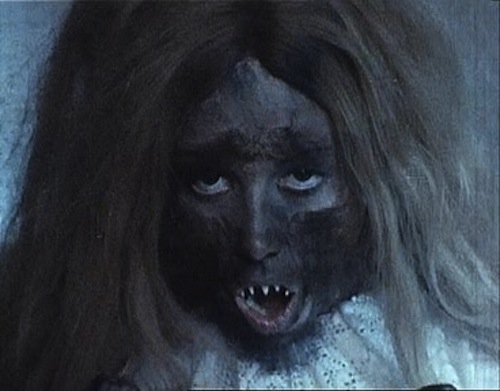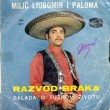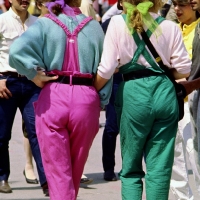Just in time for Halloween, we watched some of the best and worst horror movies from Serbia and Yugoslavia so you wouldn’t have to. From cult 1970s vampire classics to full-frontal contemporary gorno, we submitted ourselves to a variety of films that were alternately terrifying, depressing, disgusting, and dumb as dirt. You’re welcome
Leptirica (“The She-Butterfly”), Djordje Kadijevic (1973)
The so-called “first Yugoslav horror film” is worthy of its cult status. Based on the 1880 novel After Ninety Years by realist author Milovan Glisic, the film is, at its core, a genuinely Serbian vampire film. Few are aware that the word “vampire” is actually a Serbian word, and in making Leptirica, director Djordje Kadijevic went directly to its source: the villages of rural Serbia. Western film had already been appropriating the vampire mythology of southeastern Europe for decades, from Bela Lugosi to the camp Hammer Horror franchise. But Kadijevic’s film is uniquely Serbian, and retains parts of vampire mythology that Western cinema apparently deemed extraneous.
Set in a small Serbian village, the plot follows a young man named Strahinja who pines desperately for Radojka, a pale beauty with long, straw-colored hair. She’s a bit reminiscent of Winona Ryder in Edward Scissorhands, if Winona Ryder’s character had embodied the demonic along with the angelic. Anyway, the local gang of impoverished drunks, including an Orthodox priest who guzzles brandy from a barrel, keg stand style, encourages the frustrated Strahinja to take over care of the mill after its former caretaker is violently murdered by some kind of beast-like creature. After one night in the mill, Strahinja is attacked in much the same manner but manages to survive. At this point, the drunken villagers realize that long-dead village vampire Sava Savanovic must be the culprit, and drive a stake through the ground under which he is buried.
When this happens, a small moth or butterfly emerges, an integral feature of Serbian vampire lore discarded in Western vampire films. All of this happens with an eerie soundtrack of traditional choral singing. Strahinja ultimately manages to get Radojka to marry him, but on the night before their wedding, everything literally goes to hell: the beautiful young woman becomes a terrifying She-beast and tries to kill him.
Like all cult films, Leptirica is shrouded in legend: one man in Skopje allegedly had a heart attack while watching the film when it first aired, prompting some communist party members to describe Leptirica as a “terrorist film”. The movie has never been released on DVD, much to the chagrin of the director, and instead remains locked up in the dusty film archives of RTS (Radio Television of Serbia) to this day.
Variola Vera, Goran Markovic (1982)
Though this film is as old as Michael Jackson’s Thriller, it’s actually a fairly convincing portrayal of what a deadly epidemic quarantine scenario might look like. Made in the years immediately following Tito’s death, it is also a quietly dissident film that reveals some of the early cracks in Yugoslavia’s crumbling facade.
The fact that the film was based on actual events definitely ups the fear factor. In 1972, a Muslim pilgrim went to the Middle East and brought a wooden flute and a raging case of small pox back with him. When he got home, he infected dozens of people. Since there hadn’t been a case of small pox in Yugoslavia since 1930, it took doctors weeks to figure out what the disease was. By the time the epidemic was contained, 35 people were dead.
The film attempts a faithful reproduction of these events, and features lots of depressing things like greedy doctors who hoard vaccines for themselves, children with terrifying skin lesions, and patients suffering in dimly lit socialist hospitals with poor heating. It’s also incredibly old-fashioned, in that doctors light up cigs inside medical facilities, and the film’s “good guy” (the “Hungarian” silver fox from Eyes Wide Shut who tries to seduce a married Nicole Kidman) essentially sexually assaults a young nurse and no one bats an eyelash.
So while the movie drags in places (there’s only so much doctor/nurse romantic intrigue one can stomach while watching the dying moan as they claw at their bloody pustules), it’s actually a solid film. The state is also lambasted here in the depiction of a few crooked officials who conspire to get an apparently well-connected nurse out of the quarantined hospital though she’s been exposed to the virus. In another scene that critiques the body politic, an official ominously tells a group of doctors and party members, “We mustn’t let this panic become a weapon to enemies of our country and our system.”
In general, Variola Vera is an interesting enough film for fans and students of realistic horror, late Yugoslav social decomposition, and infectious diseases.
Life and Death of a Porno Gang, Mladen Djordjevic (2009)
Drawing upon certain themes from Yugoslavia’s “Black Wave” of the early 1970s, Life and Death of a Porno Gang brings those on the absolute margins of society front and center, in all their naked vulnerability.
In the immediate aftermath of the revolution that brought down Slobodan Milosevic, a young filmmaker named Marko is enthusiastic about directing his first film. He can’t find any funding for this, however, and ends up agreeing to make pornography for some cash. Marko’s film ends up being too arty for his benefactor, who is more of a classicist, and as such, prefers things like golden showers to Marko’s surrealism. So Marko flees Belgrade with a gang of social outcasts with the aim to put on a sort of traveling pornographic cabaret.
In the group we have two gay men with AIDS, a heroin-addicted mother and father of two small children, an overweight woman, and a failed actress. Perhaps unsurprisingly, these performances (which spare no form of extreme sex, including beastiality) don’t go over too well with the villagers of rural Serbia, and the gang soon finds itself completely destitute.
At this point, Marko is approached by a former war correspondent from Germany, who, without the war to sate his taste for violence and Balkan exploitation, is in the business of curating snuff films for a select and wealthy Western audience. He tells Marko that the gang will be paid well for shooting snuff films, and out of desperation, Marko agrees.
All subjects of the snuff films go willingly and violently. Oddly, it is in these scenes that Porno Gang is strangely and touchingly humane. Those who go willingly are all, to varying degrees, different kinds of victims of the Balkan wars of the 1990s. In certain instances, these victims – like the porno gang – are also perpetrators. This fact mirrors the disintegration of Yugoslavia itself: though all nations clamored for victim status and an uncomplicated righteousness (including the West), none could honestly describe itself in such terms. None could point the finger without having the finger pointed back at itself.
Of course, participation in the production of snuff films for Western audiences (a performance of inter-Balkan brutality that the foreign market had developed a taste for), proves unsustainable, and the porno gang finds itself unprotected, both from the crooked police and their own self-destructive impulses. Despite the extreme images of horror and sex, the Life and Death of a Porno Gang is ultimately a deeply sad film, and succeeds as an allegory for life in contemporary Serbia viewed from those pushed to its margins.
Zone of the Dead, Milan Konjevic and Milan Todorovic (2009)
And now for some levity. Zone of the Dead is an incredibly shitty film, yet not quite shitty enough to be unintentionally hilarious. It’s an eco-conscious zombie flick about a polluted Pancevo, here referred to as “the most polluted city in Europe” (not quite; that’s probably somewhere in Ukraine).
Basically NATO is conducting some evil exercises and somehow some zombie gas gets let out into the atmosphere. A lot of people turn into zombies. The Serbian president is an honest man and his office look like the Vatican. He is the most decent character of all and wants the Serbian people to know the truth.
Did the Serbian government pay for this film? The movie’s only real asset is that it features Ken Foree from Dawn of the Dead (1978) in a leading role as some kind of undercover American government agent escorting a prisoner from the provinces to Belgrade. But the plot doesn’t matter. It features a joint American and Serbian cast, which was fleetingly interesting, as an American living in Serbia. There is a zombie nun in one scene, and that was mildly subversive/cool. Other than that, it’s a worthless waste of 1 million dollars and an hour and a half of your life. The whole film is dimly lit, probably because the producers couldn’t afford a proper lighting crew, and the dubbing is stiff and robotic. For some reason the camera kept swaying in a weird way, and by film’s end, I had a migraine and vertigo. Don’t see it. Flee.
A Serbian Film, Srdjan Spasojevic (2010)
You probably already have an opinion about A Serbian Film even if you haven’t seen it. Banned in several countries and cut to shreds by censors in others, A Serbian Film is as violent, horrific, and disturbing as you’ve heard. Perhaps even more so. The film is made with some technical skill, and in its first third, builds suspense relatively well. Like Life and Death of a Porno Gang, the film intends to be an allegorical tale about the degradation of the individual, the family, and general morality by a criminal, authoritarian state.
While that point came across to me, its sheer brutality and lack of humanity, coupled with its stupid and obvious attempts to justify itself, nearly negates that point entirely. That said, Western audiences have often missed certain aspects of the film, and the context in which the director constructs the story.
Zarana Papic described the Milosevic period in Serbia in her essay, “Women in Serbia: Post-Communism, War, and Nationalist Mutations”, in which the state “systematically diminishes and humiliates the basic human values of decency, honesty, tolerance, individual morality, or even more basic assumptions, such as the concept of time (past, present, future), and those principles assumed to be eternally valid, such as personal identity, or the simple ten commandments (Love thy neighbor and Thou shalt not kill).” A Serbian Film certainly goes about voyeuristically obliterating those human values. But the problem with the film is that it merely confirms Papic’s statement, rather than submit it to any kind of worthy criticism.
Plot-wise, we have a washed up ex-porn star and family man named Milos, looking to make a buck. Like Marko in Porno Gang, he reluctantly succumbs to the pressure to perform acts he doesn’t really want to (and in this case, doesn’t really know the details about before he performs them) out of financial desperation. Again, the invisible but omnipresent “Western market” is mentioned as an incentive. Terrible violent things happen that you’ve probably already heard about. The message of all of this can basically be reduced to a single statement: the Serbian state fucks you from the time you are born, until you die, and even after you are dead. While that may be true, and while A Serbian Film may rightly demonize the exploitative and stupid state, it demonizes itself in much the same way.















